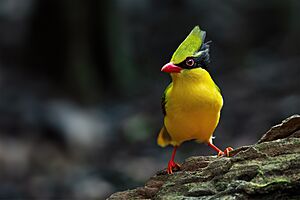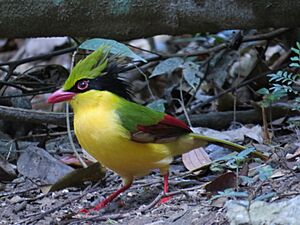Indochinese green magpie facts for kids
Quick facts for kids Indochinese green magpie |
|
|---|---|
 |
|
| Conservation status | |
| Scientific classification | |
| Genus: |
Cissa
|
| Species: |
hypoleuca
|
The Indochinese green magpie (Cissa hypoleuca) is a small, colorful bird. It's also called the yellow-breasted magpie. You can find it in the forests from China all the way to Vietnam.
Contents
About This Bird
This small bird is about 35 centimeters long. That's about the length of a ruler! It has bright, glowing feathers, just like other birds in its group, the Cissa genus. Most of its body is green. Some of these birds, especially in Southeast Asia, have a yellow belly. But the ones in China usually have green bellies, like other Cissa birds.
They have a black stripe that looks like a mask. This stripe goes from their beak, over their bright red eyes, and to the back of their head. It looks a bit like the mask Zorro wears! Their long wing feathers are reddish-brown. Their beak and legs are a bright red color. Both male and female birds look quite similar. However, young birds have duller colors than the adults. Their colors can also look duller if they spend too much time in bright sunlight.
Bird Family Tree
The Indochinese green magpie was first described in 1885. It belongs to a group of birds called Cissa. This group also includes three other short-tailed magpie species: the common green magpie (Cissa chinensis), the Javan green magpie (Cissa thalassina), and the Bornean green magpie (Cissa jefferyi).
The name Cissa comes from an old Greek word for "jay" or "magpie." All these Cissa birds look very much alike. They all have green feathers, shiny red beaks, and that cool black mask. They are part of the Corvidae family. This family includes many well-known birds like crows, ravens, and jays. The Indochinese green magpie is also a "perching bird." This means it's in the order Passeriformes, which has more than half of all bird species!
Types of Indochinese Green Magpies
There are five different types, or subspecies, of the Indochinese green magpie:
- C. h. jini lives in Southeast China.
- C. h. concolor lives in Northern Vietnam.
- C. h. chauleti lives in Central Vietnam.
- C. h. hypoleuca lives in East Thailand and South Indochina.
- C. h. katsumatae lives on Hainan island in southern China.
Where They Live
Their Home
You can find the yellow-breasted magpie in wet forests. These are usually in warm, tropical, and subtropical areas. Their bright green feathers help them blend in perfectly with the leaves. This is why they mostly stay high up in the tree branches. Being hidden in the trees helps protect them from animals that might try to hunt them.
Where to Find Them
These birds are native to Asia. You can find them in China, Laos, Thailand, and Vietnam. They can live in places as high as 1,500 meters (about 4,900 feet) above sea level. They live in a very large area, about 1,920,000 square kilometers. They stay in these areas all year long and do not fly to different places for the seasons.
How They Behave
This perching bird is quite loud! It loves to spend time in the leafy parts of its forest home. You might see them alone, in pairs, or in small groups. Sometimes, they even hang out with other birds like laughingthrushes and drongos. The Indochinese green magpie stays in its home area and does not migrate. It mainly eats meat and a lot of different things. One Indochinese green magpie lived for 18 years while being cared for by humans. When they hunt, they sneak up on their prey, corner it, and then the male bird usually makes the kill.
What Sounds They Make
Like many birds in the crow family, the Indochinese green magpie is a songbird. This means it can control its voice box, called a syrinx, very well. They can make many different sounds. These include noisy chattering, rough notes, screeches, and clear ringing whistles. They can even make a high-pitched sound that sounds like "po-puueeee-chuk," followed by a lower "eeeoooeeep groak."
What They Eat
The yellow-breasted magpie eats many different things because it is a meat-eater. Its diet includes small frogs, insects, the eggs of snakes and lizards, and baby birds. The insects they eat often feed on plants rich in something called lutein. Lutein is a yellow color that helps turn the Cissa birds from blue to bright green! If a bird doesn't get enough lutein, it might look more blue because its body can't make this color on its own.
Reproduction
These birds seem to breed in May. In places where they are cared for by humans, they have been known to lay about four eggs. They hide their nests in trees, usually about two to three meters (6 to 10 feet) off the ground. Their nests look like a bowl made from small branches.
Protecting These Birds
In 2016, the IUCN Red List said the Indochinese green magpie was of "least concern." This means they are not currently in great danger. However, their numbers are slowly going down. The decline isn't big enough yet for them to be considered at risk.
One reason for this decline is that their forest homes are being destroyed in some areas, like Hainan. Another problem is that people sometimes catch them illegally to keep as pets. Their bright, beautiful colors make them popular exotic pets, especially for birdwatchers. It's hard to know exactly how many Indochinese green magpies there are in the world right now.
The Photo Ark
In July 2022, National Geographic announced something special. The Indochinese green magpie was the 14,000th animal photographed for The Photo Ark. This project aims to photograph every species in the world!



